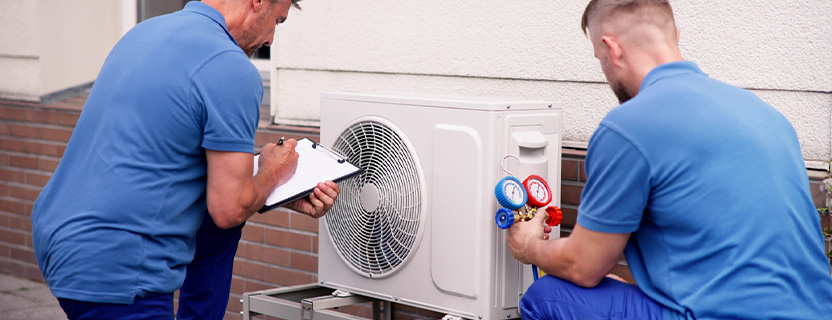A well-ventilated home not only promotes better indoor air quality but also ensures that your HVAC system operates efficiently, keeping your energy bills under control. Ventilation is a critical component of your HVAC system, allowing fresh air to circulate while removing stale, polluted air. Unfortunately, many homeowners overlook the importance of proper ventilation, often focusing solely on heating and cooling. However, a well-balanced ventilation system plays an essential role in maintaining a comfortable and healthy living environment.
In this article, we’ll explore the top 10 ventilation tips to help you get the most out of your HVAC system, improve air quality, and reduce energy costs.
1. Regularly Replace Air Filters
One of the simplest yet most effective ways to improve the ventilation in your home is to replace your HVAC system’s air filters regularly. Dirty filters restrict airflow, making it harder for your HVAC system to move air through the home. Not only does this strain the system, but it can also lead to a buildup of dust, dirt, and allergens in the air, affecting indoor air quality.
Air filters come in various MERV (Minimum Efficiency Reporting Value) ratings. Higher MERV ratings mean better filtration, capturing smaller particles like pollen, dust, and pet dander. Make sure to choose the right filter for your home’s needs, and replace it every 1 to 3 months to keep your HVAC system running smoothly.
2. Use a Whole-House Ventilation System
A whole-house ventilation system is designed to provide consistent, controlled airflow throughout your entire home. These systems work by bringing in fresh outdoor air and exhausting stale indoor air. There are several types of whole-house ventilation systems, including exhaust, supply, and balanced ventilation systems.
Exhaust ventilation systems work by creating negative pressure, pulling air out of the home. Supply ventilation systems introduce fresh air into the home, creating positive pressure. Balanced ventilation systems, on the other hand, bring in and exhaust equal amounts of air, maintaining neutral pressure in the home. Investing in a whole-house ventilation system can significantly improve indoor air quality and make your HVAC system more efficient.
3. Consider Energy Recovery or Heat Recovery Ventilators (ERVs and HRVs)
Energy Recovery Ventilators (ERVs) and Heat Recovery Ventilators (HRVs) are advanced systems designed to improve both ventilation and energy efficiency. These devices bring in fresh outdoor air while recovering the energy from the exhaust air, either in the form of heat or humidity, and transferring it to the incoming air. The result is fresh air without sacrificing the energy efficiency of your heating and cooling system.
ERVs and HRVs are particularly valuable in tightly sealed homes, where natural ventilation may not be sufficient. They help to maintain a comfortable and healthy indoor environment without causing a spike in energy bills.
4. Seal Ducts to Prevent Air Leaks
Leaky ducts can significantly reduce the effectiveness of your ventilation system and decrease energy efficiency. Air leaks in your ducts allow conditioned air to escape, causing your HVAC system to work harder to maintain the desired temperature. This not only raises your energy bills but can also lead to poor ventilation and inconsistent air distribution throughout the home.
Sealing your ducts is a relatively simple and cost-effective way to improve both ventilation and energy efficiency. Use mastic sealant or specialized duct tape to seal any visible leaks, and consider having a professional HVAC technician conduct a full duct inspection to ensure that your ducts are properly sealed and insulated.
5. Install a Programmable Thermostat
A programmable thermostat allows you to schedule your HVAC system to operate at specific times of the day. By controlling the timing of your system’s operation, you can ensure that the ventilation system is running when needed, optimizing energy usage. For instance, you can program your system to run when you are home and reduce its activity when you’re away, saving both energy and money.
Additionally, some modern thermostats come with air quality monitoring features, allowing you to monitor the levels of pollutants, humidity, and other factors that can affect your indoor air quality. By adjusting the ventilation based on real-time data, you can maintain a healthy and comfortable living environment without wasting energy.
6. Ensure Proper Humidity Control
Humidity plays a significant role in both indoor air quality and HVAC system performance. High humidity levels can create a breeding ground for mold and mildew, while excessively dry air can cause discomfort and exacerbate respiratory issues. To maintain optimal air quality, it’s essential to keep humidity levels between 30% and 50%.
Investing in a whole-house dehumidifier or humidifier can help regulate humidity levels throughout your home. Some HVAC systems come with built-in humidity control, but adding an additional unit may be necessary for homes in areas with extreme humidity levels. Proper humidity control can improve both your comfort and the efficiency of your HVAC system.
7. Opt for Proper Ventilation in Specific Rooms
Certain areas of your home, such as the kitchen, bathrooms, and laundry rooms, generate moisture and contaminants that can degrade indoor air quality if not properly ventilated. These rooms require dedicated ventilation to ensure that humidity, odors, and pollutants are removed quickly.
Install exhaust fans in high-moisture areas like bathrooms and kitchens to expel humidity and prevent mold growth. Similarly, ensuring proper ventilation in laundry rooms will help eliminate excess moisture from drying clothes. By addressing the ventilation needs of specific rooms, you can improve air quality throughout your home and prevent potential damage to your HVAC system.
8. Maintain Outdoor Vents and Air Intakes
Many HVAC systems rely on outdoor vents and air intakes to bring in fresh air from the outside. Over time, these vents can become clogged with debris, such as leaves, dirt, and bird nests, restricting airflow and reducing the effectiveness of your system. Ensure that your outdoor vents are clean and free of obstructions to allow for proper airflow.
Regularly inspect the exterior of your home for any debris buildup and clean out the vents as needed. This small maintenance task can help keep your HVAC system operating efficiently and prevent unnecessary strain on your ventilation system.
9. Check for Airflow Obstructions
In addition to ensuring that your ducts are sealed and your vents are clear, it’s essential to check the airflow in each room of your home. Furniture, rugs, and other objects can obstruct airflow, causing uneven ventilation and making it harder for your HVAC system to maintain a comfortable temperature.
Perform a thorough check of your home and move any furniture or objects that may be blocking air vents or registers. This will help improve airflow, ensure proper ventilation, and allow your HVAC system to distribute air evenly throughout the home.
10. Schedule Regular HVAC Maintenance
Finally, one of the best ways to ensure that your ventilation system is working properly is to schedule regular maintenance for your HVAC system. A professional technician will inspect and clean your system’s components, including filters, ducts, and fans. Regular maintenance helps prevent issues such as clogged filters, dirty coils, and leaky ducts, all of which can reduce ventilation efficiency and increase energy costs.
Ideally, schedule HVAC maintenance twice a year—once in the spring before the cooling season and once in the fall before the heating season. This ensures that your system is ready for the demands of each season and helps maintain optimal ventilation and air quality year-round.
Conclusion
Good ventilation is essential for a healthy, comfortable, and energy-efficient home. By following these top 10 ventilation tips, you can ensure that your HVAC system operates at its best, improving air quality, reducing energy costs, and extending the life of your system. Whether it’s investing in a whole-house ventilation system, sealing ducts, or simply maintaining clean filters, each step you take will make a noticeable difference in the overall comfort and efficiency of your home. A little attention to ventilation goes a long way toward creating an environment that’s both healthier and more cost-effective.

